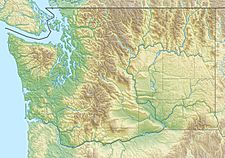Lillian Glacier facts for kids
Quick facts for kids Lillian Glacier |
|
|---|---|
| Type | Mountain glacier |
| Coordinates | 47°51′09″N 123°22′38″W / 47.85250°N 123.37722°W |
| Length | .04 mi (0.064 km) |
| Terminus | Talus |
| Status | Retreating/extinct |
The Lillian Glacier was once a small glacier located in the beautiful Olympic Mountains in Olympic National Park in the state of Washington, USA. It was a mountain glacier, meaning it formed high up in the mountains. Today, only small pieces of ice remain in a bowl-shaped area called a cirque, which is found below McCartney Peak. Sadly, between 1905 and 2010, most of the Lillian Glacier melted away. Scientists believe this happened because of the Earth's warming climate.
Contents
What is a Glacier?
A glacier is like a giant, slow-moving river of ice. It forms over many years when snow falls in the same place and doesn't melt completely. As more snow piles up, it gets compressed and turns into ice. This ice then slowly flows downhill due to gravity.
How Glaciers Form
Glaciers need special conditions to form:
- Cold temperatures: The air must be cold enough for snow to stay frozen for most of the year.
- Lots of snow: There needs to be enough snowfall each winter to add to the ice.
- Gentle slope: A slight slope helps the ice to slowly move.
Types of Glaciers
There are different kinds of glaciers. The Lillian Glacier was a mountain glacier, also known as an alpine glacier. These glaciers form in high mountain valleys and flow down the slopes. Other types include ice sheets, which are huge areas of ice covering entire continents, like in Antarctica.
Lillian Glacier: Location and History
The Lillian Glacier was a small but important part of the Olympic Mountains. These mountains are known for their rugged beauty and are home to many glaciers.
Where It Was Found
The glacier was located within Olympic National Park. This park is a special place in Washington state, famous for its diverse landscapes. It has tall mountains, thick forests, and a wild coastline. The Lillian Glacier was nestled in a high-altitude cirque, which is a natural amphitheater carved by glaciers. This cirque is just below McCartney Peak.
Its Past Size
At its largest, the Lillian Glacier was about 0.04 miles long. While this might seem small compared to some giant glaciers, it was still a significant feature of the local landscape. Glaciers like Lillian help shape mountains by carving out valleys and cirques.
Why Did Lillian Glacier Melt?
The main reason the Lillian Glacier melted away is believed to be global warming. This is a term used to describe the Earth's climate getting warmer over time.
Understanding Global Warming
The Earth's climate has always changed naturally. However, scientists have observed that the planet is warming much faster now. This rapid warming is mostly due to human activities. When we burn fossil fuels like coal, oil, and natural gas for energy, we release gases into the atmosphere. These gases trap heat, making the Earth warmer.
Impact on Glaciers
Warmer temperatures cause glaciers to melt faster than they can grow. If a glacier melts more ice in the summer than it gains from snow in the winter, it will shrink. This is what happened to the Lillian Glacier. Between 1905 and 2010, the balance shifted, and the glacier lost most of its ice.
What Happens When Glaciers Melt?
When glaciers melt, it can have several effects:
- Sea level rise: Meltwater from glaciers adds to the ocean, causing sea levels to rise.
- Water supply: Many communities rely on meltwater from glaciers for drinking water and farming.
- Ecosystems: Animals and plants that depend on cold glacial environments can be affected.
The disappearance of the Lillian Glacier is a clear sign of how climate change is impacting our planet's natural features.


